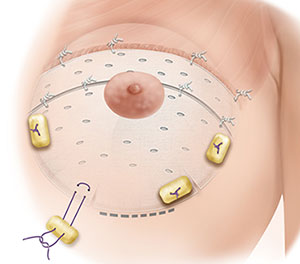Procedure Video
Procedure Overview
These procedures are performed under general anesthesia. There are many steps involved so five hours of surgical time is common to treat both sides. However, because this is essentially “surface surgery” and the implant pockets are already established, this surgery is usually very well tolerated and an uneventful recovery is typical.
The original breast implants and the surrounding scar capsule are first removed either through an incision around the areola (periareolar) or under the breast in the crease (inframammary) The implant pocket is then lined with acellular dermal matrix (ADM) from the edge of the pectoral muscle to the breast crease (Figure 1). The goal is to form a complete biologic barrier between the breast tissue and the implant surface. After placing drains a new implant is placed under the ADM after it is secured in place with sutures.
Aftercare and Follow-Up
The drains and external breast crease sutures are removed at one week. The incision sutures are of the “dissolving” type and do not need removal. A regular underwire bra is started and worn until six weeks after surgery. Upper body and impact exercises are avoided for this period and gradually resumed thereafter. Ultimately, there are no activity restrictions. Follow-up visits occur at intervals for the first year, and yearly thereafter. As with all breast augmentation procedures, the implants will require periodic replacement, usually not before ten years. Saline implants, while less popular, often last much longer and require no special monitoring of their integrity.
Treatment of Capsular Contracture with ADM (Videos)
Inframammary Incision Approach
Periareolar Incision Approach


